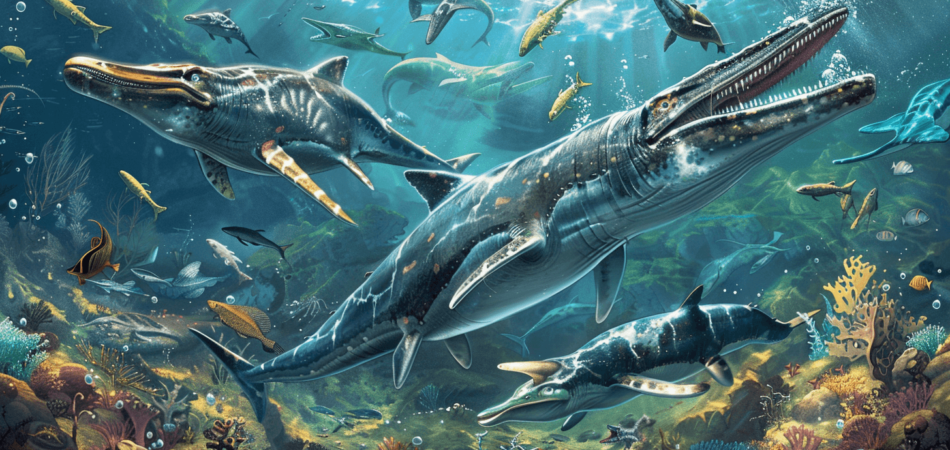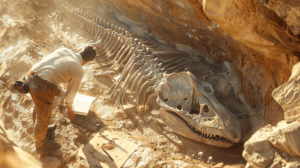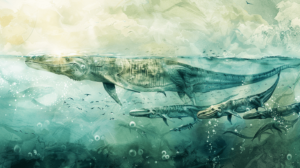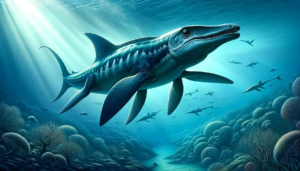Aardonyx Guide:
Aardonyx was an early dinosaur that lived in South Africa about 200 million years ago.
Aardonyx was an early dinosaur that lived in South Africa about 200 million years ago.

Just as a well-orchestrated symphony captivates its audience with a harmonious blend of instruments, the ichthyosaurs ruled the ancient seas with a combination of physical adaptations and behaviors perfectly tuned for marine supremacy. These creatures, with their dolphin-like forms and keen hunting abilities, present a fascinating chapter in the story of evolution. Yet, beneath their successful adaptation lies a tale of vulnerability – a testament to the delicate balance of life. Unraveling the secrets of their existence offers not just a glimpse into a world long gone but also poses intriguing questions about survival, adaptation, and extinction in the ever-changing tapestry of life on Earth.

illustration of a scientist uncovering a large, well-preserved ichthyosaur fossil in a cliffside
The journey to uncovering ichthyosaurs began with early fossil finds that captivated the curiosity of scientists and the public alike. Researchers employed various exploration techniques to unearth more about these marine reptiles’ anatomy and lifestyle. These initial steps laid the groundwork for a deeper understanding of ichthyosaurs, revealing their crucial role in the history of marine life.
Several early illustrations and fossil discoveries in the late 17th and early 18th centuries laid the groundwork for our understanding of ichthyosaurs. Pioneers like Edward Lhuyd and Johann Jakob Scheuchzer first sketched what they saw in unearthed bones, sparking intrigue.
These contributions were instrumental in the scientific community’s ongoing quest to understand ichthyosaurs.
Exploration techniques for uncovering ichthyosaurs have significantly evolved, yielding detailed anatomical insights and groundbreaking fossil discoveries. Initially, early illustrations by pioneers like Edward Lhuyd and Johann Jakob Scheuchzer sparked curiosity, but it was the discovery of significant finds near Bath and the efforts of the Annings that propelled the understanding of ichthyosaurs. They unearthed complete skeletons, providing invaluable anatomical data. These advancements in exploration techniques, from simple digging to more sophisticated methods, have enabled researchers to piece together the life of ichthyosaurs. Such methods have not only led to the discovery of extensive fossil records but also to a deeper understanding of anatomy, showcasing the evolutionary journey of these magnificent marine reptiles.

The evolutionary journey of ichthyosaurs began with their origins and ancestry, tracing back to terrestrial ancestors in the late Permian or earliest Triassic period. Over millions of years, they adapted remarkably to marine life, developing streamlined bodies and large eyes for deep ocean hunting. These adaptations highlight their successful transition from land to sea, marking a significant chapter in their evolutionary story.
Ichthyosaurs, often recognized for their dolphin-like appearance, embarked on their evolutionary journey from terrestrial ancestors in the late Permian or earliest Triassic period. Originating as land-dwelling creatures, these marine reptiles underwent significant adaptations to thrive in oceanic environments.
Understanding their origins and ancestry allows us to appreciate the complexity of ichthyosaur evolution and their specialized adaptations for life in the sea.
Over their evolutionary journey, ichthyosaurs transitioned from land-dwelling amniotes to dominant marine predators, showcasing remarkable adaptability. Their evolution is deeply intertwined with the diversification into various ecological niches, reflected in the anatomical data collected over time. Recent research indicates they are part of a monophyletic clade within the Diapsida clade, closely related to Sauropterygia and Thalattosauria.
| Evolutionary Stage | Key Adaptation |
|---|---|
| Land to Sea Transition | Development of paddle-like limbs |
| Diversification | Adaptation to various ecological niches |
| Peak in Late Triassic | Streamlined bodies for efficient swimming |
This table illustrates the significant milestones in the evolutionary journey of ichthyosaurs, highlighting their adaptability and dominance in marine environments.

Streamlined bodies and paddle-like limbs made ichthyosaurs agile predators of the ancient oceans. These marine reptiles thrived in their aquatic realm, exhibiting a remarkable suite of physical characteristics that equipped them for life beneath the waves. Their fish-like tail provided powerful propulsion, while their paddle-like appendages ensured precise maneuverability. The ichthyosaurs’ sharp teeth were ideal for seizing slippery prey, and their fleshy dorsal fins aided in stabilization during high-speed chases.
To convey a deeper meaning for the audience, consider these features:
These physical attributes not only highlight the ichthyosaurs’ adaptations to their marine habitat but also underscore their success as predators within the ancient oceans’ ecosystems.
@ Midjourney AI Image Prompt:
Exploring the behaviors and ecology of ichthyosaurs sheds light on their hunting strategies and reproductive habits. These marine reptiles utilized their speed and visual acuity to track and capture prey, indicating a complex approach to feeding. Additionally, their practice of giving birth to live young highlights a unique aspect of their life cycle in the marine environment.
Ichthyosaurs mastered a variety of hunting strategies, including suction feeding, ram feeding, and pursuit predation, to dominate their marine environments. Their streamlined bodies and powerful tail movements allowed them to swiftly navigate through the water, while their large eyes aided in spotting prey in low light conditions. These apex predators adapted their techniques to capture a wide range of prey, from fish to other marine reptiles.
After mastering various hunting strategies, these ancient creatures also exhibited remarkable reproductive behaviors, including the unique ability to give birth to live young in their marine environments. Ichthyosaurs’ reproductive behavior was adapted perfectly for life in the aquatic habitat, allowing for immediate offspring care that likely boosted survival rates. Their strategy of live birth, rather than laying eggs, marked a significant evolutionary adaptation to the marine environment
| Feature | Detail |
|---|---|
| Live Birth | Yes, in marine environments |
| Embryos | Found in adults, indicating pregnancy |
| Litter Size | Up to 10 embryos |
| Offspring Care | Immediate, enhancing survival rates |
| Adaptation | Suited for aquatic habitat reproduction |
This table encapsulates the essence of ichthyosaurs’ reproductive habits, highlighting their remarkable adaptations for successful reproduction in the challenging conditions of the ancient oceans.
@ Midjourney AI Image Prompt: /imagine prompt:Create an image depicting a meteor impact in the ocean, with ichthyosaurs swimming below, while volcanic eruptions and a drastically changing climate are visible in the background, illustrating the multifaceted reasons for their extinction. –v 6 –ar 16:9
Exploring the reasons for the extinction of ichthyosaurs opens up a realm of scientific inquiry. The speculation around an asteroid impact provides one potential explanation, but other factors likely played significant roles as well. This section will examine these possibilities to better understand why these marine reptiles disappeared from the oceans.
Why did the Ichthyosaurs go extinct if not by the devastating impact of an asteroid, as was the case with many dinosaurs? Unlike the mass extinction event that marked the end of many prehistoric creatures, the disappearance of Ichthyosaurs is attributed to a complex interplay of factors. These ancient marine reptiles faced their mysterious end well before the asteroid impact that extinguished the dinosaurs.
Delving into the reasons for their extinction, scientists consider a lack of resources in their ocean habitats as a key factor contributing to the demise of Ichthyosaurs. Warming oceans and a decline in the prey they depended on likely played significant roles as well. These environmental factors combined to create conditions that were unsustainable for Ichthyosaurs, leading to their extinction. Unlike some marine reptiles that adapted, Ichthyosaurs couldn’t survive the rapidly changing conditions. This decline happened in the early Jurassic period, about 30 million years before the mass extinction event that ended the era of the dinosaurs. It’s evident that a complex interplay of factors, beyond just a single event, contributed to the loss of these remarkable creatures from our ocean habitats.
Interestingly, someone’s curious about the ancient sea-dwellers, the ichthyosaurs! They had massive eyes, snacked on seafood, and didn’t bother with egg-laying. Instead, they delivered live mini-mes, swimming swiftly with their streamlined bodies. Talk about oceanic trendsetters!
No, ichthyosaurs couldn’t breathe underwater. They were air-breathing reptiles, similar to dolphins, needing to surface for air. Their adaptations allowed them to dive deep but required regular returns to the surface to breathe.
Ichthyosaurs, the ocean’s ancient predators, feasted on fish and squid, much like a shark patrols the seas today. Their sharp teeth and fossil finds, including stomach contents, reveal a diet rich in marine delicacies.
The ichthyosaur lived for about 186 million years, thriving from the early Triassic to the late Cretaceous period. They adapted well to marine life but eventually faced extinction due to changing environmental conditions. During the Triassic period, ichthyosaurs evolved unique adaptations that allowed them to become proficient swimmers, resembling modern dolphins in their body shape and lifestyle. A Triassic period overview highlights how various environmental shifts and the emergence of new species provided both challenges and opportunities for these marine reptiles. Despite their impressive evolutionary success, the eventual warming of the climate and shifts in oceanic ecosystems ultimately contributed to their decline.
In conclusion, ichthyosaurs, with their remarkable adaptations, ruled the ancient oceans for over 160 million years, showcasing the incredible diversity of life on Earth. Their dolphin-like bodies and keen hunting abilities made them formidable predators. Yet, despite their prowess, they couldn’t withstand the drastic environmental shifts, leading to their extinction. This serves as a poignant reminder of nature’s fragility and the impact of changing climates on species survival. With every discovery, ichthyosaurs continue to fascinate, unveiling the mysteries of our planet’s past.